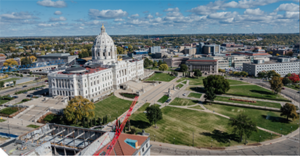Minnesota’s Next Bonding Bill
Addressing Cities’ Critical Infrastructure and Housing Needs
By Suzy Frisch

St. Michael — like many cities across Minnesota — is in a bind. It’s facing new state clean water regulations to upgrade and expand its aging wastewater treatment plant. To complete the project’s required $20 million in improvements, the city is seeking $7 million in funding assistance through the state capital investment bonding bill.
But the Legislature failed to pass the bill in May 2024, following its trend during three of the four most recent legislative sessions. Last session, bonding proposals didn’t even make it to either chambers’ floor. The House approved a $70 million cash investment bill minutes before the session ended, but the Senate did not vote on it. The Legislature’s inaction has left cities across the state in limbo as their infrastructure needs stack up and costs climb.
Lengthy to-do list
From fixing deteriorating roads and bridges to rehabilitating public housing, there is vast demand to improve and maintain Minnesota’s infrastructure. Even though the Legislature passed a significant bill in 2023 — including $2.6 billion in bonding and cash investments — the state still has $5 billion in pending requests for additional capital investment needs, said former state Rep. Dean Urdahl (R-Grove City). A perennial leader during 20 years of bonding bill deliberations, Urdahl notes that the backlog is sky-high because the Legislature didn’t enact a bonding bill in 2021 or 2022.

Minnesota’s overall demands for infrastructure spending are extensive in communities big and small, whether for new projects or preservation of existing facilities. Hundreds of wastewater plant improvements alone will clock in at $12 billion during the next 20 years, though the state doesn’t foot the entire bill, said Craig Johnson, senior intergovernmental relations representative for the League of Minnesota Cities.
The American Society of Civil Engineers issues an annual report card of each state’s infrastructure. Its most recent report for 2022 gave Minnesota’s drinking water infrastructure a C- while roads earned a D+ and bridges got a C. The state’s bridges will require $8.2 billion in rehabilitation and repairs during the next 20 years, while Minnesota’s roads will need $17.7 billion in upkeep — or $885 million annually.
“If you don’t do bonding, you have unmet needs that continue to grow, and the prices go up. It just makes it more expensive to do the things we should have done in the first place,” Urdahl said. “It’s wrong to play political games with the health and safety of the people of Minnesota. We are elected and sent to St. Paul to serve the interests of our district and the people of the state. If you have infrastructure problems, you should deal with them.”
How politics impact bonding
The requests for capital investment funding are piling up because Minnesota has fallen off its traditional bonding cadence. For 50 years, the Legislature shaped each two-year term, or biennium, to function either as a budget year or a bonding year. Odd years usually are when lawmakers set the state’s budget for the next two years. Then in even years, they typically approve the issuance of long-term bonds to pay for a wide array of public works projects.
A bonding bill’s reach spreads across Minnesota, contributing funds to diverse needs like building maintenance at state colleges and universities, cities’ police and fire stations, and investments in natural resources. However, getting the bill passed can be a heavy lift that often becomes politicized because a supermajority of both chambers must authorize the spending, Johnson said. In recent years, either each party controlled one chamber, or one party controlled the House and Senate but with slim margins, making it challenging to secure enough votes.
Urdahl has retired, leaving with the perspective that the bonding bill now must overcome another roadblock. It has been turned into a bargaining chip lately, he said. The parties used to negotiate for various spending priorities within the bill. Since 2019, when Republicans became the minority party, it’s become more common to hold up the bonding bill entirely to achieve other legislative goals.
Unfortunately, cities like St. Michael get caught in the middle. Infrastructure needs like repairing roads and bridges and upgrading wastewater treatment plants to meet new state and federal regulations wait on the backburner. Minnesota’s main funding source for wastewater projects, the Point Source Implementation Grant program, had a $101 million pot that was drained by projects receiving funding in 2023. The program requires new state bonding dollars to direct money to municipal projects like St. Michael’s, enabling the city to provide residents with basic services, said Steve Bot, city administrator and public works director for St. Michael.
“The bonding bill has been a great opportunity to meet infrastructure needs that the community otherwise might not be able to afford without state help,” Bot said. “Roads, bridges, sewers, and wastewater projects aren’t flashy, but they are essential, and they cost a lot of money. There’s an expectation by the public that we make those things happen.”

Sometimes, cities find that they can’t wait any longer to fix a crumbling road or improve the performance of a water treatment facility. “But then it’s all on the city taxpayers’ dime, and those are tough decisions to make,” Bot adds. “Sometimes you have to wait and keep patching things together with the hope that the funds will eventually come, and sometimes you have to make a decision to move ahead without the funds.”
In addition, cities risk missing out on federal matching grants for water and sewer projects when the state doesn’t contribute its share of funding. It becomes a lost opportunity to move projects forward, Johnson said.
There are other challenges when lawmakers don’t approve bonding. Applicants’ proposals have a shelf life. If a request for bonding money stays unfunded for too long, cities must renegotiate and rebid contracts with vendors. Then the work usually becomes more expensive because of rising costs for materials and labor, Johnson said.
“There is a ton of infrastructure that was planned that is not being built,” he adds. “We have this desperate backlog of projects that can’t start, even though they are all planned and ready to go.”
Help for housing
Housing is another vital area supported by bonding bills — and the need for funding is constant. The federal Department of Housing and Urban Development (HUD) built thousands of housing units in Minnesota that are operated by communities’ public housing authorities. Spread across the state in cities of all sizes, many units were built in the 1950s and 60s and require substantial repairs. Though HUD provides some funding, it’s not enough to cover the properties’ extensive needs, said Jennifer Leimaile Ho, commissioner of Minnesota Housing.
“This is where some of our aging Minnesotans and people with disabilities are living, and they are on fixed incomes. There’s often no other place in the community where they can afford to live. These buildings have deteriorating HVAC systems and broken elevators and literally windows falling off the sides of buildings,” Ho said. “The level of repair we see in this program is really intense. So public housing preservation is a really high priority for us, and if you’re a city it’s an important community asset.”
In 2023, the Legislature approved a record $1.3 billion for housing, including $82 million in cash and general obligation bonds for public housing rehabilitation. Yet there is still a lengthy list of housing stock waiting for repairs, Ho said. Another channel for preserving affordable housing comes from Minnesota’s housing infrastructure bonds. Usually privately owned, this housing stock is HUD-subsidized to keep rent affordable. Such units also require a significant investment in upkeep to ensure that they remain safe and high-quality places for Minnesotans to live, Ho said.
Gov. Tim Walz’s 2024 bonding proposal designated $57.5 million for housing. It recommended $50 million for housing infrastructure bonds to develop additional multifamily developments for people who are homeless, seniors, and families, plus single-family development and manufactured home community infrastructure. The proposal directed another $7.5 million to public housing rehabilitation. Without these dollars, vital new housing doesn’t get built, significant repairs go uncompleted, and the list of needs grows unabated, Ho said.
“When we fund less, we build less. The housing market in America is largely a private market endeavor, and what we do with precious government resources is focus on affordability for people who can’t play in the private market,” Ho said. “In Minnesota, we are at least 50,000 units short of what we need, and the gap is greatest for people who are low income. That’s where the government subsidy to build or create affordability is really critical.”
What’s next?
The question on many city leaders’ minds is whether the Legislature will take up bonding as part of its regular business in 2025. Traditionally, a bonding bill wouldn’t be considered until 2026. The jury is out. “I wish I could say I’m an optimist, but I’ve gone through too many of these circumstances over the years to take anything for granted,” Urdahl said. “I would say I’m hopeful that they can get it done. I really wish they could just realize that my gosh, the people of Minnesota depend on us to do it.”
During the 2024 session, Minnesota Management and Budget gave the state a $930 million bonding target. One proposed bill included $600 million for state projects and more than $330 million to be split among Democrats and Republicans in both chambers, who would determine how to disburse the funds locally. The state will know more after the next economic forecast is released in February, giving Walz and lawmakers a sense of Minnesota’s bonding capacity in 2025.
City leaders can help inspire the Legislature to act, making the case that they need support to keep their infrastructure in good working order and meet federal mandates. Treating water and wastewater have many new regulations, including updated clean water standards and the required removal of chemicals like per and polyfluoroalkyl substances (PFAS).
“We have a strong case that we cannot afford any more delays, and local infrastructure needs are at an urgent level,” Johnson said. “We have to get the money because there will be significant impacts.”
One of those impacts includes stifling growth. Communities are having trouble expanding to accommodate new businesses and housing developments. Many can’t afford to build the necessary roads and expand their infrastructure capacities for water and sewer to meet newcomers’ needs, Johnson said.
The League also will be fighting recent efforts to require local governments to show that they have money set aside to pay for expansion, rehabilitation, and eventual replacement of their requested projects. Otherwise, the state would not send bonding dollars their way.
“It’s like saying you can’t get a loan for your car until you show you have money in the bank to pay for it,” Johnson said. “That would make the state no longer a viable source for funding for anything.”
Lobbying has been fierce to block such measures, with arguments that cities don’t request funds from the Legislature without a plan, up-front investments of time, effort, and funds, and money set-aside for future maintenance and improvements. Johnson argues that while cities should be planful and prepared before they request state funds, Minnesota’s own capital improvement planning and vetting process already should provide sufficient guardrails.
Suzy Frisch is a freelance writer.

